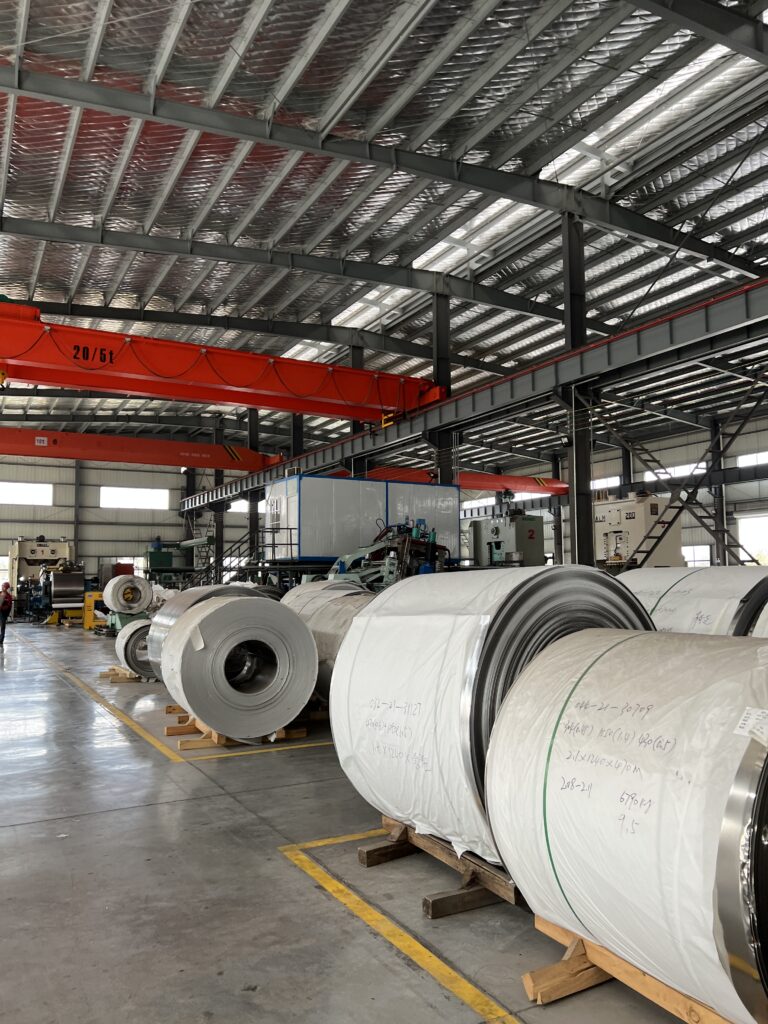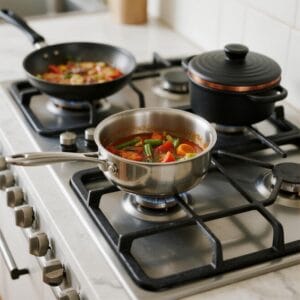Introduction
In the world of cookware, choosing the right material is crucial for achieving the best cooking results. Triply circle material is increasingly recognized as a superior choice due to its multi-layer construction, combining the best properties of stainless steel and aluminum. This material offers excellent heat distribution, durability, and versatility, making it a favorite among both professional chefs and home cooks.
In this article, we compare triply circle material with other common materials used in cookware manufacturing, such as stainless steel, cast iron, copper, and non-stick aluminum. We explore the unique benefits and drawbacks of each to help you understand why triply circle material stands out.
What Is Triply Circle Material?
Triply circle material consists of three bonded layers: an inner stainless steel layer, a middle aluminum core, and an outer stainless steel layer. The stainless steel provides strength, corrosion resistance, and a non-reactive cooking surface, while the aluminum core ensures fast and even heat distribution. This combination results in a high-performance cooking material suitable for a variety of culinary tasks.
Production Process of Triply Circle Material
The production process of triply circle material involves several critical steps to create a durable and efficient composite suitable for high-quality cookware. The process can be broken down into the following stages:
- Material Preparation: The production begins with selecting high-quality stainless steel and aluminum sheets. The stainless steel used for the inner and outer layers is typically food-grade, ensuring safety and durability, while the aluminum layer is chosen for its excellent heat conductivity properties.
- Layering and Bonding: The three layers—inner stainless steel, aluminum core, and outer stainless steel—are carefully layered together. The bonding process is conducted through a method called roll bonding. In this process, the layered sheets are passed through high-pressure rollers, which fuse the metals together at a molecular level. This creates a permanent bond between the layers, ensuring that they work as a single, unified piece of material.
- Heat Treatment: After bonding, the triply material undergoes a heat treatment process. This step involves subjecting the bonded layers to high temperatures to further strengthen the bond and enhance the material’s durability. Heat treatment also helps to relieve any internal stresses that may have developed during the roll bonding process, ensuring the final product remains stable and warp-resistant during use.
- Cutting and Shaping: Once the bonding and heat treatment are complete, the triply material is cut and shaped into the desired forms for different types of cookware. This could include frying pans, saucepans, stockpots, and more. The cutting process is precise to ensure that each piece of cookware meets strict quality standards.
- Forming and Polishing: The shaped pieces are then formed into their final cookware shapes using deep drawingor stamping techniques. This involves pressing the flat sheets into molds to create the three-dimensional shapes of the cookware. After forming, the cookware undergoes polishing to give it a smooth, attractive finish. The stainless steel exterior is polished to either a mirror or satin finish, ensuring the cookware is both aesthetically pleasing and easy to clean.
- Quality Control and Testing: The final step in the production process is quality control. Each piece of cookware is inspected for defects, and its performance is tested to ensure it meets the required standards for heat distribution, durability, and safety. This ensures that only the highest quality cookware reaches the consumer.









Material Composition of Triply Circle Material
- Inner Layer (Stainless Steel): The inner layer is made from food-grade stainless steel, which is non-reactive, ensuring that it does not alter the taste of food or react with acidic ingredients. This makes it safe for cooking a wide variety of dishes.
- Middle Layer (Aluminum): The middle layer consists of aluminum, which is an excellent conductor of heat. This aluminum core plays a crucial role in ensuring rapid and even heat distribution across the entire cooking surface, reducing the risk of hot spots and uneven cooking.
- Outer Layer (Stainless Steel): The outer layer is also made of stainless steel, which provides the cookware with strength, durability, and corrosion resistance. Additionally, the stainless steel exterior makes the cookware compatible with induction cooktops, further enhancing its versatility.
Product Features of Triply Circle Material
- Multi-Layer Construction: The combination of stainless steel and aluminum in triply cookware allows for the best of both materials—durability from stainless steel and efficient heat conduction from aluminum.
- Induction Compatibility: Thanks to the stainless steel exterior, triply cookware is suitable for use on induction cooktops, as well as gas, electric, and ceramic stoves.
- Even Heat Distribution: The aluminum core ensures that heat is evenly distributed throughout the cooking surface, preventing hot spots and ensuring consistent cooking results.
- Durability and Resistance: The stainless steel layers provide excellent resistance to rust, corrosion, and warping, ensuring that the cookware remains in great condition even after prolonged use.
- Non-Reactive Surface: The stainless steel inner layer ensures that the cooking surface is non-reactive, making it safe for cooking acidic foods like tomatoes and citrus.
Applications of Triply Circle Material in Cookware
- Frying Pans and Skillets: Triply circle material is ideal for frying pans and skillets due to its even heat distribution, which ensures perfect searing, browning, and frying of food. The stainless steel exterior also makes it easy to clean and highly durable.
- Saucepans and Stockpots: Saucepans and stockpots made with triply material are perfect for cooking soups, stews, and sauces, as they maintain a consistent temperature and prevent burning.
- Sauté Pans: Triply sauté pans benefit from the precise temperature control offered by the aluminum core, making them ideal for sautéing vegetables and proteins.
- Dutch Ovens: Triply material is also used in Dutch ovens, which require excellent heat retention for slow-cooking recipes. The multi-layer construction ensures that heat is evenly distributed and retained, allowing for perfectly cooked dishes.
- Bakeware: Some bakeware is also made from triply circle material, which provides even heating for baked goods, reducing the risk of uneven cooking or undercooking.


Triply Circle Material vs. Stainless Steel
- Heat Distribution: Triply material features an aluminum core, which greatly enhances heat distribution compared to standard stainless steel cookware. This ensures more even cooking and prevents hot spots.
- Weight: Stainless steel cookware is often lighter than triply due to the absence of an aluminum core. However, this weight reduction can come at the cost of uneven cooking.
- Durability: Both triply and stainless steel cookware are highly durable, with excellent resistance to rust and corrosion. However, triply cookware’s multi-layer construction makes it more versatile for a wider range of cooking techniques.
- Cooking Efficiency: Triply circle cookware is more efficient at conducting and retaining heat, which reduces cooking times compared to stainless steel-only cookware.
Triply Circle Material vs. Cast Iron
- Heat Retention: Cast iron is known for its exceptional heat retention, which makes it great for slow cooking and frying. Triply material, while also offering good heat retention, heats up faster and distributes heat more evenly.
- Weight: Cast iron cookware is significantly heavier than triply, which can make it cumbersome to use. Triply circle material offers a balance between weight and performance, making it easier to handle.
- Maintenance: Cast iron requires regular seasoning to maintain its non-stick properties and prevent rust, whereas triply cookware is easier to maintain with its stainless steel layers.
- Versatility: Triply cookware is versatile across various stovetops, including induction, gas, and electric. Cast iron can also be used on different stovetops, but it is less convenient due to its weight and need for careful maintenance.
Triply Circle Material vs. Copper Cookware
- Heat Conductivity: Copper is an excellent conductor of heat, providing precise temperature control. However, triply circle material, with its aluminum core, offers similar heat conductivity without the high cost and maintenance associated with copper.
- Maintenance: Copper cookware requires frequent polishing to maintain its appearance, whereas triply cookware has a stainless steel exterior that is much easier to care for.
- Reactivity: Copper is reactive with certain foods and often requires a stainless steel lining to prevent this. Triply circle material’s stainless steel layers provide a non-reactive cooking surface, making it a safer choice for all types of ingredients.
- Cost: Copper cookware is often more expensive than triply due to the cost of raw copper and the labor-intensive manufacturing process. Triply cookware offers similar performance at a more accessible price point.
Triply Circle Material vs. Non-Stick Aluminum Cookware
- Heat Distribution: Non-stick aluminum cookware provides decent heat distribution but lacks the evenness that triply circle material offers due to its aluminum core bonded with stainless steel.
- Durability: Non-stick coatings can wear off over time, reducing the effectiveness and safety of the cookware. Triply circle cookware, with its stainless steel surface, is more durable and can withstand higher cooking temperatures.
- Cooking Techniques: Triply cookware can handle high-heat cooking methods, such as searing and browning, which non-stick aluminum cannot, due to the limitations of the non-stick coating.
- Health Considerations: Non-stick coatings can degrade over time and release harmful chemicals if overheated. Triply circle material’s stainless steel inner surface is non-toxic and does not degrade over time, ensuring healthier cooking.
Advantages of Triply Circle Material Over Other Materials
- Even Cooking: The aluminum core in triply circle material ensures consistent heat distribution, which is crucial for even cooking results and reducing the risk of burning.
- Versatility: Triply cookware is suitable for a wide range of cooking techniques, from searing to slow cooking. It is also compatible with all stovetop types, including induction.
- Low Maintenance: Unlike copper or cast iron, triply cookware requires minimal maintenance. The stainless steel surface is easy to clean and resistant to rust and corrosion.
- Health and Safety: Triply circle material provides a non-reactive stainless steel surface, ensuring that no harmful chemicals or metallic tastes leach into food.
Challenges of Triply Circle Material
- Weight: Triply cookware can be heavier than standard aluminum or stainless steel cookware due to its multi-layer construction. This may be a consideration for those who prefer lightweight cookware.
- Cost: The manufacturing process for triply circle material is more complex, resulting in a higher cost compared to single-material cookware options like stainless steel or aluminum.
Future Trends in Cookware Manufacturing
As the demand for high-performance cookware grows, triply circle material is expected to continue gaining popularity. Innovations in bonding technology and the development of lighter, more efficient core materials could enhance the performance of triply cookware even further. Consumers are also increasingly seeking cookware that is versatile across multiple stovetop types, and triply circle material meets this requirement, making it a key player in the future of cookware manufacturing.
FAQs about Triply Circle Material and Comparisons in Cookware Manufacturing
- What makes triply circle material different from standard stainless steel cookware?
- Triply circle material includes an aluminum core that provides superior heat distribution compared to standard stainless steel cookware.
- Is triply cookware better than cast iron for everyday cooking?
- Triply cookware is lighter, heats more evenly, and is easier to maintain compared to cast iron, making it ideal for everyday cooking.
- Can triply circle material be used on induction cooktops?
- Yes, the stainless steel exterior of triply cookware makes it compatible with induction cooktops.
- How does triply circle material compare to copper in terms of heat conductivity?
- Copper is an excellent heat conductor, but triply circle material offers similar heat distribution without the high cost and maintenance required by copper.
- Is triply cookware non-stick?
- Triply cookware is not inherently non-stick, but it offers excellent searing capabilities. Non-stick coatings can be added for added convenience.
- What are the advantages of triply cookware over non-stick aluminum cookware?
- Triply cookware is more durable, can handle higher cooking temperatures, and provides a non-reactive cooking surface, unlike non-stick aluminum, which can degrade over time.
- How does the weight of triply cookware compare to other materials?
- Triply cookware is heavier than standard aluminum but lighter than cast iron, providing a good balance between weight and performance.
- Are there any health concerns with triply circle material?
- No, triply circle material is made with stainless steel and aluminum, both of which are non-toxic and safe for cooking.
- Why is triply cookware more expensive than other options?
- The multi-layer construction and bonding process are more complex, leading to higher production costs compared to single-material cookware.
- Can triply cookware withstand high heat without warping?
- Yes, triply cookware is designed to withstand high heat without warping, ensuring consistent performance over time.
- How does triply cookware compare to cast iron in terms of maintenance?
- Triply cookware is easier to maintain than cast iron, as it does not require seasoning and is resistant to rust.
- Is triply circle material suitable for acidic foods?
- Yes, the stainless steel surface is non-reactive, making it safe for cooking acidic foods like tomatoes and citrus.
- What are the common uses for triply circle frying pans?
- Triply circle frying pans are ideal for searing, browning, sautéing, and frying due to their even heat distribution and durability.
- Can triply cookware be used in the oven?
- Yes, most triply cookware is oven-safe and can handle high temperatures, making it versatile for different cooking methods.
- Why is triply circle material considered versatile compared to other materials?
- Triply circle material combines the best properties of stainless steel and aluminum, making it suitable for various cooking techniques and compatible with all stovetop types, including induction.
Conclusion
Triply circle material stands out among other cookware materials for its superior heat distribution, durability, versatility, and low maintenance. While it comes with challenges like weight and cost, the benefits it offers make it a preferred choice for both professional chefs and home cooks. By combining the best properties of stainless steel and aluminum, triply circle material provides a high-quality cooking experience that meets the needs of a wide variety of cooking techniques and preferences.







3 Responses
I am considering purchase of stainless steel cooker or my kitchen however I found two types of cookers 1 is normal stainless steel in induction bottom and other is triply stainless Steel material
Pl suggest which offer is better
Regards
Dear Vinod
Thank you for your inquiry. As a factory specializing in high-end cookware materials, I highly recommend Triply Stainless Steel over normal induction bottom cookware.
Here is the key difference:
Triply Stainless Steel (Best Option):
The aluminum core runs through the entire body (both the bottom and the sidewalls).
Benefit: Cooks food faster and evenly from all sides (3D heating). No “hot spots,” so food does not burn easily. This is the material used by top premium brands.
Normal Induction Bottom (Capsule Bottom):
The aluminum disk is only attached to the bottom base.
Drawback: Heat does not travel well up the walls. The food at the bottom cooks fast, but the rest cooks slowly, often leading to uneven results.
Conclusion:
If you want superior quality, energy efficiency, and a better cooking experience, Triply is the much better choice.